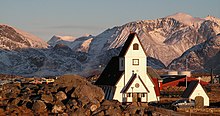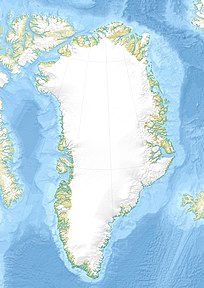Nanortalics
| Nanortalik (place of the bears) | ||
|---|---|---|
| Nanortalics | ||
| Nanortalik Church | ||
| Commune | Kujalleq municipality | |
| District | Nanortalics | |
| Geographical location | 60 ° 8 '30 " N , 45 ° 14' 35" W | |
|
|
||
| Residents | 1,185 (January 1, 2020) |
|
| founding | 1830 | |
| Time zone | UTC-3 | |
Nanortalik [ naˈnɔtːalik ] is a Greenland city in the Nanortalik district in Kujalleq municipality .
location
Nanortalik is located on an island of the same name in front of a peninsula that is separated by the Tasermiut Kangerluat (Ketilsfjord). The island of Nanortalik is sometimes very narrow at this point and extends into the sea with a chain of peninsulas. Nanortalik is the southernmost city in Greenland. The next town is Tasiusaq , which is 24 km east-northeast.
history
Nanortalik was founded in 1830 when the plant from Sissarissoq was moved to the other side of the bay due to the better harbor conditions. Nanortalik's old name was Ilivileq . The buildings from the founding period are now part of the Nanortalik Museum . Nanortalik used to be a popular trading post between Kitaamiut and Tunumiit .
From 1911 Nanortalik was a separate community in the colonial district Julianehaab, to which the Tuapaat , Sermilik and Illukasik residential areas still belonged. The island of Amitsoq also belonged to the municipality , where graphite was mined from 1915 to 1925 . The municipality was part of the 2nd district electoral council of South Greenland.
In 1919 5 Europeans and 284 Greenlanders lived in Nanortalik. The population included the Danish colonial administrator as administrator of the facility, two boatmen, four cooperators, a colonist, a midwife, a nurse, two catechists, 46 hunters and a fisherman. The residents made a living mainly from seal hunting. The Greenlanders lived in 27 houses. The manager lived in a 111 m² house, which had been built in 1904 and comprised four rooms, a kitchen and an attic room. It replaced an older administrator's apartment from 1836, which measured only 65 m². The grocery store was built in 1897. There was also a bacon house from 1852, a trading house from 1853, a distillery from 1839, a workshop from 1848, a cooperage, a team house, a bakery and brewery, a stable, a powder house and a hospital with two nurses and nurses' rooms. The church dates from 1913 and was built in the Danish style. The school was 62 square meters and had two classrooms and a catechist's room.
Nanortalik, which until then was the only remaining facility in the country alongside Kangersuatsiaq , became a separate municipality during the administrative reform in 1950 and thus received city rights in 1953, just like Narsaq .
List of colonial employees until 1921
The following sales assistants were active as administrators of the Nanortalik plant until 1921.
- 1797-1820: David Lars Emanuel Kleist
- 1820–1826: Immanuel Arøe
- 1826–1834: Jacob Andreas Augustinus Arøe
- 1834–1835: Ove Kielsen
- 1835–1836: Henning Ager
- 1836–1838: Jacob Andreas Augustinus Arøe
- 1838–1841: Ove Kielsen
- 1841–1842: Emanuel Joachim Balling
- 1842–1845: Peter Hanning Motzfeldt
- 1845–1850: Johan Christoph Ehrenfried Kauffeldt
- 1850–1863: Johannes Haberdorff Lytzen
- 1863–1869: Carl Emil Olfert Lytzen
- 1869–1870: Lorentz Frederik Mathiesen
- 1870–1874: Ulrik Frederik Rosing
- 1874–1875: Johan Frederik Holm
- 1875–1879: Henrik Martinus Rosenstand
- 1879–1881: Rasmus Müller
- 1881–1883: Carl Julius Peter Ryberg
- 1883–1884: Jakob Magnus Christian Bang
- 1884–1885: Henrik Martinus Rosenstand
- 1885: Peder Jacob Eskild Lund (interim)
- 1885–1888: Johan Christian Simony
- 1888-1892: Andreas Peter Rye Jørgensen
- 1892-1893: Valdemar Møller
- 1893–1895: Carl Ringsted
- 1895–1896: Konrad Olsen Bugge
- 1896–1899: Niels Peter Johannes Frandsen
- 1899–1903: Konrad Olsen Bugge
- 1903–1908: Carl Peter Lauritz Mathiesen
- 1908–1910: Oluf Hastrup
- 1910–1912: Carl Peter Lauritz Mathiesen
- 1912–1913: Søren Nielsen (interim)
- 1913–1915: Christian Simony
- from 1915: Carl Peter Lauritz Mathiesen
economy
Fishing and hunting are traditionally the largest economic factor in Nanortalik, but their importance is decreasing. The residents are also increasingly working in service professions. The Nalunaq gold mine added mining as an economic pillar , just as tourism in Nanortalik is gaining in importance as the place has become a popular destination for cruise and adventure tourists.
Infrastructure and supply
The port structures of Nanortalik consist of a quay for fishing boats and larger ships, a slipway , a quay for schooners and leisure boats, a pontoon jetty for dinghies and an emergency harbor. Air traffic currently runs through the Nanortalik heliport , but an airfield is to be built north of the city in the next few years.
The buildings in Nanortalik are connected to a sewage network that directs all sewage into the sea. The garbage is dumped and incinerated in the garbage dump in the east of the city. A power station supplies the city with electricity. From the Kuunnguaq River, which runs to the west , water is fed into Lake Tasersuaq , from where it reaches the waterworks, where it becomes drinking water.
Development
In Nanortalik there is a fish factory, a workshop, a hospital, a hotel, a church, a sports hall, a soccer field, a Pilersuisoq and a Brugseni branch.
Sons and daughters
- Jens Hansen (1872–?), Provincial Councilor
- Henrik Lund (1875–1948), poet, pastor, catechist, missionary, painter and councilor
- Josva Kleist (1879–1938), catechist, poet and councilor
- Johannes Mathiesen (1881–?), Provincial Councilor
- Aage Bugge (1896–1979), Danish-Greenlandic pastor, provost, teacher, university rector and writer
- Jørgen Poulsen (1920–1973), councilor, catechist, teacher and sheep farmer
- Carl Egede (1924–1959), Member of the State
- Marius Abelsen (1929–1972), regional councilor and teacher
- Ole Korneliussen (* 1947), writer
- Simon Simonsen (* 1961), politician (Siumut), teacher and former soccer player, coach and cross-country skier
- Isle Hessner (born 1962), artist
- Jens B. Frederiksen (* 1967), politician (Demokraatit), police officer and entrepreneur
- Frederik Elsner (* 1986), badminton player and musician
- Josef Tarrak-Petrussen (* 1998), rapper and film producer
Population development
For a long time, the population of Nanortalik ranged between 1,400 and 1,600. Since shortly after the turn of the millennium, the population has been falling. Between 2003 and 2018, Nanortalik lost around a quarter of its population.

panorama
Web links
Individual evidence
- ↑ Map with all official place names confirmed by Oqaasileriffik , provided by Asiaq
- ↑ Louis Bobe : Beskrivelse af Distrikterne i Sydgrønland: Julianehaab district. History . In: Georg Carl Amdrup , Louis Bobé , Adolf Severin Jensen , Hans Peder Steensby (eds.): Grønland i tohundredeaaret for Hans Egedes landing (= Meddelelser om Grønland . Volume 60-61 ). tape 2 . C. A. Reitzel Boghandel, Copenhagen 1921, p. 557 ( digitized version in the Internet Archive ).
- ^ Sabine Barth: Greenland . 4th edition. DuMont Reiseverlag, Ostfildern 2017, ISBN 978-3-7701-7307-5 , p. 150 f .
- ^ Ole Bendixen : Beskrivelse af Distrikterne i Sydgrønland: Julianehaab district. Bopladser i Julianehaab district. Anlægget Nanortalik . In: Georg Carl Amdrup , Louis Bobé , Adolf Severin Jensen , Hans Peder Steensby (eds.): Grønland i tohundredeaaret for Hans Egedes landing (= Meddelelser om Grønland . Volume 60-61 ). tape 2 . C. A. Reitzel Boghandel, Copenhagen 1921, p. 523 ff . ( Digitized in the Internet Archive ).
- ↑ Nanortalik at groenlandkreuzfahrt.de
- ↑ Jens Christian Madsen: Udsteder og bopladser i Grønland 1901-2000 . Atuagkat, 2009, ISBN 978-87-90133-76-4 , pp. 50 .
- ↑ Louis Bobe : Beskrivelse af Distrikterne i Sydgrønland: Julianehaab district. History. Danske Embedsmænd ved Julianehaab . In: Georg Carl Amdrup , Louis Bobé , Adolf Severin Jensen , Hans Peder Steensby (eds.): Grønland i tohundredeaaret for Hans Egedes landing (= Meddelelser om Grønland . Volume 60-61 ). tape 2 . C. A. Reitzel Boghandel, Copenhagen 1921, p. 558 f . ( Digitized in the Internet Archive ).
- ↑ a b c Nanortalik at kujalleq2017.odeum.com
- ↑ Population of Nanortalik 1977–2020 at bank.stat.gl




